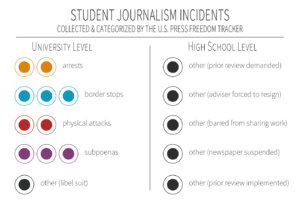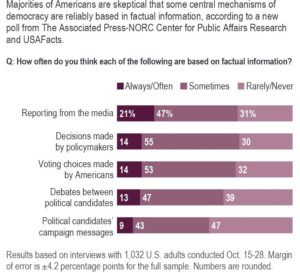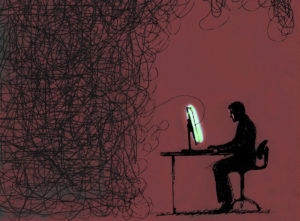Journalism, Disinformation & The Weakening 4th Estate
U.S. Press Freedom Tracker
For student journalists, the beats are the same but the protections are different
‘The U.S. Press Freedom Tracker, which documents First Amendment aggressions in the United States, has collected student journalism-based incidents at both the university and high school levels. Since its launch in 2017, the Tracker has documented five cases of high school newspapers being censored or placed under prior review for their coverage of controversial topics. At the university level, it has collected two arrests, two physical attacks and three border stop involving student journalists, as well as three cases of subpoenas or legal orders.
In recognition of the expansion of student journalism as a key source of accountability and record for their local communities, two of the Tracker’s partners—the Student Press Law Center and the Newseum—along with the Freedom Forum Institute, declared 2019 the “Year of the Student Journalist.” This year also marks the 50th anniversary of a key Supreme Court decision in favor of student First Amendment rights: Tinker v. Des Moines Independent School District.
While the Vietnam-era case of Tinker centered on students wearing armbands in protest, it has become the bellwether for free speech and journalism at both the high school and university levels. The 7-2 ruling iconically stated that neither “students [n]or teachers shed their constitutional rights to freedom of speech or expression at the schoolhouse gate.”
While Tinker holds—for now—the state of journalism is rapidly changing. With legacy newsrooms shuttering and the number of working journalists contracting as freelancers increasing, the role of the student journalist has expanded to fill some of the void.’
Why it matters: The death of local news in America is routinely cited as one of the country’s biggest threats to democracy. With fewer opportunities in local journalism and less job security at the local level, finding talent to fill local newsrooms has become a central focus.
Even without the week’s depressing report on just how widespread is the loss of local news — 400 counties and counting, with no newspaper — let us be thankful for the people who are still out there trying to be watchdogs on local institutions. “If every American gave 30 minutes a day to an earnest and open-minded effort to stay on top of the news, we might actually find our way out of this crisis.”
AXIOS
We have to talk about technocracy, how it has driven massive sociopolitical change.
Media outfits, breaking from the high-minded, dispassionate liberalism that dominated journalism in the middle decades of the 20th century, earn enormous profits by whipping millions of viewers into a frenzy of furious anger at perceived slights and condescension. Political campaigns and even whole social movements are motivated by the perception of disrespect.
Bill Moyers:
“A democracy can die of too many lies. And we’re getting close to that terminal moment unless we reverse the obsession with lies that are being fed around the country.”
NPR
If the children are the future, the future might be very ill-informed.
That’s one implication of a new study from Stanford researchers that evaluated students’ ability to assess information sources and described the results as “dismaying,” “bleak” and “[a] threat to democracy.”
As content creators and social media platforms grapple with the fake news crisis, the study highlights the other side of the equation: What it looks like when readers are duped.
The researchers at Stanford’s Graduate School of Education have spent more than a year evaluating how well students across the country can evaluate online sources of information.
In exercise after exercise, the researchers were “shocked” — their word, not ours — by how many students failed to effectively evaluate the credibility of that information.
The students displayed a “stunning and dismaying consistency” in their responses, the researchers wrote, getting duped again and again. They weren’t looking for high-level analysis of data but just a “reasonable bar” of, for instance, telling fake accounts from real ones, activist groups from neutral sources and ads from articles.
Most middle school students can’t tell native ads from articles.
The researchers showed hundreds of middle schoolers a Slate home page that included a traditional ad and a “native ad” — a paid story branded as “sponsored content” — as well as Slate articles.
Most students could identify the traditional ad, but more than 80 percent of them believed that the “sponsored content” article was a real news story.
“Some students even mentioned that it was sponsored content but still believed that it was a news article,” the researchers wrote, suggesting the students don’t know what “sponsored content” means.
Most high school students accept photographs as presented, without verifying them.
Most college students didn’t suspect potential bias in a tweet from an activist group.
The researchers sent undergraduate students a link to a tweet by MoveOn about gun owners’ feelings on background checks, citing a survey by Public Policy Polling.
“The kinds of duties that used to be the responsibility of editors, of librarians now fall on the shoulders of anyone who uses a screen to become informed about the world,” Wineburg told NPR. “And so the response is not to take away these rights from ordinary citizens but to teach them how to thoughtfully engage in information seeking and evaluating in a cacophonous democracy.”




Leave a Reply